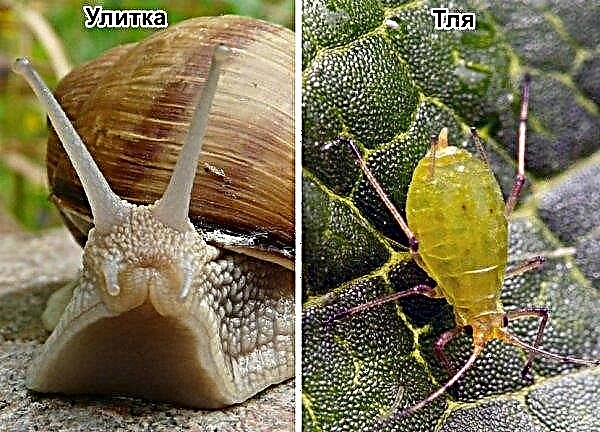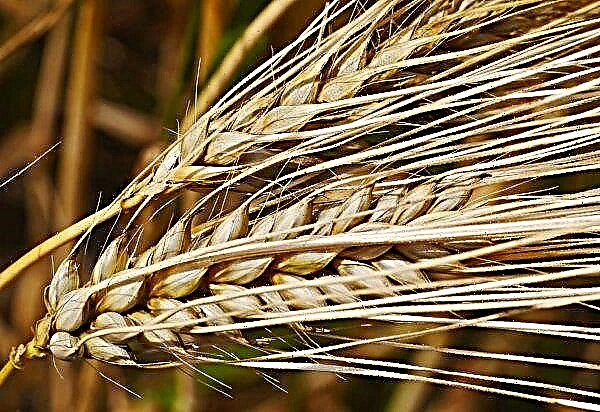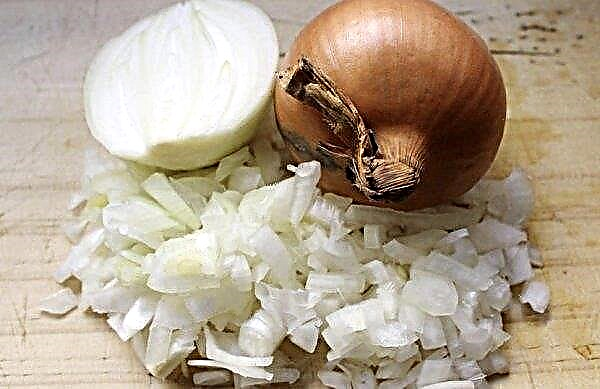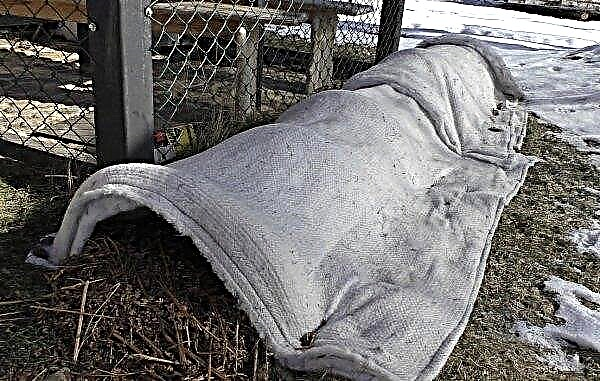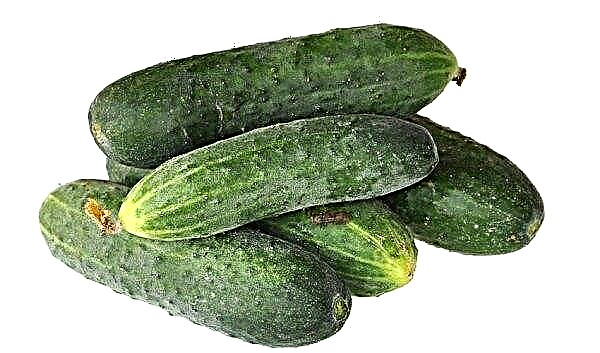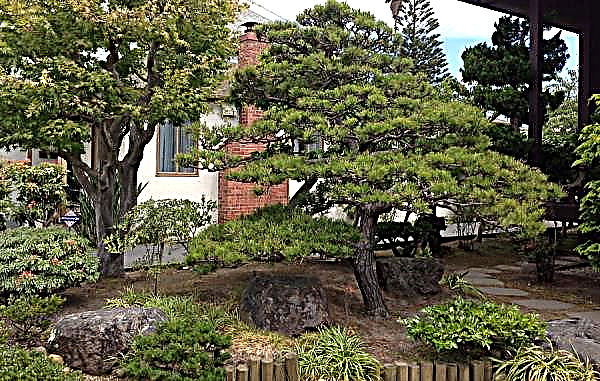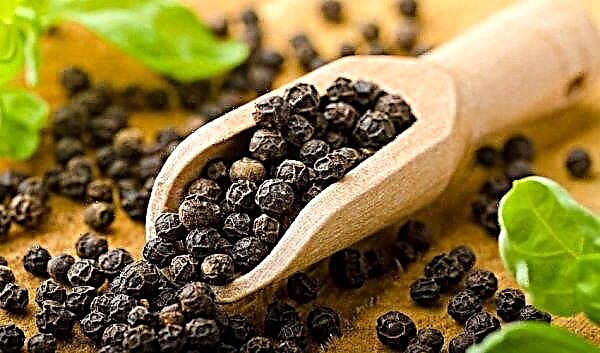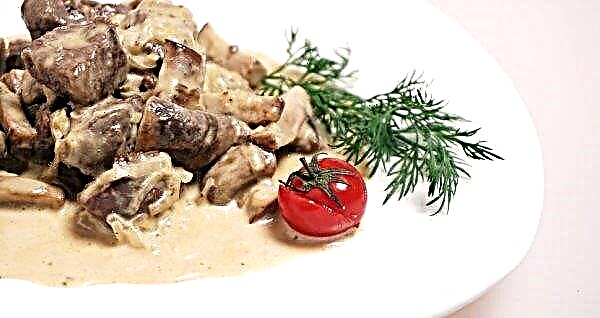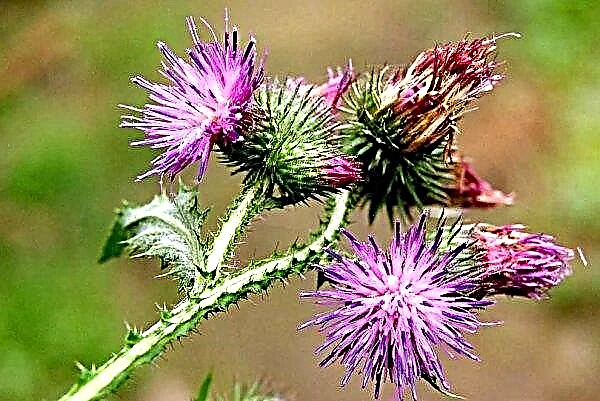Many gardeners dream of growing delicious high-yielding cucumbers, universal in application. These include a variety called Courage. We will talk about how to grow these cucumbers in our garden today.
Grade description
Let us consider in more detail the characteristics of the variety presented in the table:
| Characteristic | Description |
| Breeding (country) | Russia (Gavrish company, 2002) |
| Plant type | Parthenocarpic |
| Type of pollination | Self-pollinating grade |
| Ripening time | Mass appearance of fruits 38–45 days after planting in the summer-autumn period. In winter in greenhouses - in 50–54 days |
| Productivity | Up to 10 kg per bush |
| Bush characteristic | Strongly curly. Require careful shaping |
| Fetal weight | 130-150 g |
| Length | 15 cm on the main stem, 10-12 cm on the side shoots |
| The form | Oval-cylindrical, with little pronounced longitudinal ribs. The surface is tuberous, the edges of the tubercles are lighter than the fruit itself. Thin longitudinal light strips up to 1/3 of the fetus may appear |
| Skin | Thin, dark green, with a light wax coating |
| Pulp | Light green, delicate |
| Application | Universal: fresh consumption, for preservation, good transport tolerance. Keep fresh up to 10 days |
Advantages and disadvantages
- Cucumbers of this variety have the following advantages:
- quickly ripen;
- bring a high yield;
- resistant to diseases, pests and heat;
- have a pleasant, delicate taste;
- well tolerate transportation.
- In addition to the advantages, this variety has minor disadvantages:
- the need for careful care;
- with insufficient humidity, voids form in the fruits and bitterness appears.
Did you know? The word "cucumber" came from ancient Greece. There the fruit was called "aguros" ("unripe").
Sowing seeds for seedlings
It is recommended to grow cucumbers of this variety by the seedling method. So you will collect a larger crop than when sowing seeds directly to the garden.
Optimal timing
Sowing cucumbers is recommended in mid-spring. In early June, cucumbers are planted in the garden. The later the landing is made, the lower will be the yield.
Soil mix
A very important stage is the preparation of good soil. To do this, mix humus, turf and sawdust in a ratio of 2: 2: 1, respectively. You can also prepare a mixture consisting of turf (2 parts), humus (3 parts) and sand (1 part). It is recommended to add saltpeter, potassium sulfate, superphosphate to it.
Capacity for growing
Sowing seeds is recommended in separate shallow pots with fertile soil. Boxes or peat tablets may also be used. Wrap each container with a film and place in a warm place (+25 ° С) with a sufficient amount of light (near the battery or on the window). As soon as the seeds begin to germinate, lower the temperature to + 15-17 ° C.
Seed preparation
Before sowing, put the seeds in a saline solution (1 tbsp. L salt with a slide in 1 l of water) for 10 minutes. This will help to select the most suitable seeds (discard the pop-up, rinse the remaining ones on the bottom with water). Next, wrap them in a scarf and put in a warm place. An ideal option is a warm battery (the seeds will warm up quickly). To disinfect the seeds, they must be placed for half an hour in a solution of potassium permanganate (1 g of potassium permanganate per 100 ml of water), then rinse with clean water. The last stage is placing the germinated seeds in the refrigerator for 2-3 days (they will harden and become resistant to environmental influences).
Sowing seeds
Tanks need to be filled with soil more than half, moisten a little. Put the seeds in the soil and sprinkle with a layer of earth 2-4 cm thick. As soon as the cucumbers begin to emerge, you need to sprinkle the soil.
Seedling Care
Cucumber seedlings must be watered gradually, with the drying of the top crust of the soil (1-2 times a week), with warm water. It is better to place seedlings in a well-lit place, with an ambient temperature of at least +20 ° С. When the first true leaf appears, you need to add top dressing, which consists of 7 g of ammonium nitrate, 8 g of potassium sulfate and 15 g of superphosphate, diluted in 10 l of water.
Important! With a lack of light, plants will grow deformed, and the tips of their leaves will turn yellow due to disruption of photosynthesis.
Seedling hardening
5-7 days before the seedlings are planted on the bed, it is tempered so that it can get used to the future environment of its habitat. To do this, young shoots are daily taken out onto the street (or open balcony): first for an hour, then for two, increasing the time spent on the street to 3 hours.
Planting seedlings in a permanent place
3 weeks after germination, the seedlings are planted in a permanent place. By this time, there should be 3-4 leaflets on the bush and a formed root system with 4-5 roots.
Cucumbers are planted sparsely, otherwise their branches will be intertwined, rot, and you will not collect a good crop from them. Planting is carried out on a cool day in the evening, because on a hot day the bushes quickly tucked up.
Did you know? The birthplace of cucumbers is India (the foot of the Himalayas). In these places, wild fruits grow to this day.
Landing immediately in open ground
Cucumbers Courage is allowed to sit immediately in the garden. In this case, the yield will decrease, but the plants will be more hardened, they will better develop the root system.
Video: Planting cucumber seeds in open ground
Optimal timing
The end of spring is the best time for sowing seeds in open ground. By this time, the soil temperature should be stable, not lower than +15 ° С.
Seat selection
The best place for landing is in the sun, without drafts. To provide cucumbers with comfortable growth conditions, you need to plant them in loose soil, since it easily passes water and air.
It is advisable that in the previous season peppers, cabbage, onions or potatoes grow here. You can not plant this variety of cucumbers in the garden after gourds (watermelon, pumpkin, etc.).Important! Before planting, check the soil for acidity, as acidic soil will adversely affect the yield of this variety. Medium loamy soil is well suited.
Scheme and depth of landing
Cucumbers of this variety are grown in two ways:
- At horizontal When growing, seeds are placed at a distance of 40 cm, 3-4 pieces in a pit to a depth of 2-4 cm. Top you need to sprinkle with loose soil, cover with a film before germination. After the first sprouts appear on the surface, the film must be removed and the seedlings thinned out. Avoiding severe thickening, the lashes of cucumbers are evenly distributed on the surface of the beds.
- At upright When growing near the bushes, they put up supports for which the plants cling to their antennae. Sowing with this method is done not in the holes, but in the grooves, the distance between which should be about 1 m. The sowing depth is 2.5–3 cm, the distance between the seeds is not less than 15 cm. After germination, the cucumbers must be thinned out (the gap between two neighboring plants - 35 cm).
How to care for crops
Courage must be carefully looked after for cucumbers to get a high crop. We will talk about the features of care later.
Watering
Cucumbers Courage belong to the moisture-loving varieties. They are watered every two days with warm water, which stood for a couple of hours in the sun. One formed plant requires 4-5 liters of water. You need to water the whole garden, and not a specific bush. The fact is that the roots of these cucumbers are not deep, as a result of abundant watering, they can wash away all the soil.
You need to water the whole garden, and not a specific bush. The fact is that the roots of these cucumbers are not deep, as a result of abundant watering, they can wash away all the soil.
On hot days, you need to water the cucumbers daily. If the weather is rainy, watering can be reduced so that the soil does not become wet. If you notice that the leaves of your cucumbers fade, start watering them more often.
Top dressing
Like all fruit crops, Courage cucumbers need to be fed. It is enough to do this 4 times per season. It is better to fertilize in the evening, at sunset. Ideal - after the rain.
- For the first time, top dressing is performed 2 weeks after the cucumbers are planted in the garden. Mix manure or chicken droppings with infusion of grass in a proportion of 1:10. Herbal infusion is prepared as follows: chop the grass, fill it with a third of the container, fill it with water, close it tightly and put it in a warm place for 3-4 days. An unpleasant odor should appear in the finished infusion. The resulting mass must be filtered and diluted with water in a ratio of 1: 5. Water only with fresh infusion.
- The second time the fertilizer is performed at the beginning of flowering. Make the same infusion of herbs. You can add mineral fertilizers. To do this, mix potassium and ammonium nitrate (25 g each) with superphosphate (40 g). Dissolve all this in 10 liters of water. Pour each bush with the resulting mixture.
- The third top dressing takes place during the harvest of the first crop. To do this, use the following solution: potassium nitrate (35 g) and urea (50 g) dissolved in 10 liters of water. If desired, 200 g of ash can be added.
- After 10 days, make the last top dressing. An infusion of ash (200 g per 10 l of water) or baking soda (25-30 g per 10 l of water) is prepared. It is also useful to spray the plant with a solution of urea (15 g per 10 liters of water).
Video: 5 best dressings for cucumbers
Bush formation
The bushes of the plant must be carefully formed in accordance with the level of their growth. Pinch the main stem after 4–5 leaves, this activates the development of second-order shoots, which, in turn, pinch after 3-4 leaves. Many shoots impede the growth of all the fruits that have begun to grow; in addition, severe thickening causes the development of rot and other diseases of cucumbers.
Soil care
It is best to prepare the soil on which you plan to grow cucumbers in the fall. To do this, lay the fallen leaves, grass and manure in layers on the soil surface. Pour each layer with water. Sprinkle the top with soil and cover with a film until spring. You can also prepare the soil immediately before planting, in spring. To do this, lay on the bed with needles, rotted straw and peat. Above is a mixture of manure with ash. Sprinkle all this with a layer of soil (15–25 cm) and leave for a week.
Bush tying
When growing cucumbers in an upright position, they must be tied up. This is done as the bush grows.  Gently take the cucumber branch and tie it to the support. Tying will prevent the branches of neighboring plants from touching and intertwining, which can cause rot. In addition, a tied plant will breathe well and it will have enough sunlight.
Gently take the cucumber branch and tie it to the support. Tying will prevent the branches of neighboring plants from touching and intertwining, which can cause rot. In addition, a tied plant will breathe well and it will have enough sunlight.
Preventative treatment
This variety is extremely resistant to disease. But preventative treatment cannot be dispensed with.
- So that cucumbers do not become infected with powdery mildew, they should be sprayed with the “Quadris” tool.
- To avoid the appearance of white rot, do not water the soil. If the disease could not be avoided, cut off the diseased branches.
- If you notice signs of ascogitosis on cucumbers, spray the affected plants with a 2% solution of Bordeaux mixture.
- To avoid fusarium, pour boiling water over the soil for planting cucumbers.
- To prevent bacteriosis, protect the cucumber bed from drafts. If you notice signs of this disease, remove the affected leaves, and spray the plant with a Bordeaux mixture (2% solution).

Harvesting
Harvesting begins in mid-July. If the cucumbers are properly looked after, it is possible to collect up to 10 kg of fruits from one bush. Harvesting is carried out every 2 days as the fruit grows.
The fruits do not lose freshness for 10 days. A prerequisite is a cool storage temperature and the absence of direct sunlight. The ideal place for them is the cellar. Store cucumbers in wooden crates or cardboard boxes.Important! Avoid overexposure of cucumbers on the branches, because because of this, young ovaries will not arise.
 Cucumbers Courage is the dream of every gardener. High yield, wonderful taste, resistance to diseases, good tolerance of transportation, versatility in use - all these qualities distinguish this variety from others. With proper care, these cucumbers will delight you with quick ripening and excellent taste.
Cucumbers Courage is the dream of every gardener. High yield, wonderful taste, resistance to diseases, good tolerance of transportation, versatility in use - all these qualities distinguish this variety from others. With proper care, these cucumbers will delight you with quick ripening and excellent taste.

